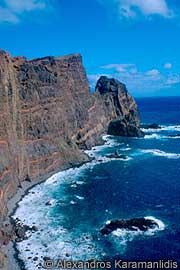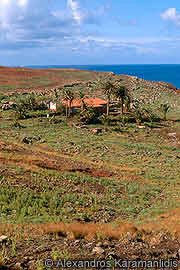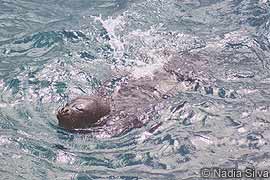|
HOMEWARD BOUND
Are monk seals returning to Madeira's São Lourenço peninsula?
Alexandros A. Karamanlidis, Rosa Pires,
Henrique Costa Neves and Carlos Santos
When reflecting on the life history of the Mediterranean monk seal over the past century, one might be tempted to liken it to a mathematical equation. Human development in coastal areas, competition between monk seals and fishermen for dwindling marine resources, and the inexorable thirst of the tourism industry for unspoiled beaches have led most monk seal populations to the brink of extinction with almost mathematical certainty. The list of capes, bays, peninsulas, islets and other places that once used to be home to the Mediterranean monk seal is as long as it is tragic. Despite the recognition that habitat loss must be countered with the creation of marine protected areas (MPAs), little has been done to achieve that aim. Consequently, monk seals have disappeared from much of their former range. In the central and western Mediterranean, it is likely that the species has already fallen well bellow survival limits. The second half of the 20th century also witnessed the eradication of monk seals from the Black Sea and Marmara (Kiraç 2001).
Following the same, all-too-familiar pattern, the archipelago of Madeira was also on its way to becoming another monk seal graveyard. Commercial exploitation and deliberate killings by fishermen had reduced population numbers dramatically, leaving only 6-8 individuals clinging to survival at the remote Desertas Islands by 1984 (Reiner & Santos 1984).
The 1990s, however, marked the beginning of a fundamental shift in human attitudes towards this rare seal, symbolising the profound manner in which planned and dedicated human action can benefit an endangered species. In order to protect Monachus monachus, the Parque Natural da Madeira Service (PNMS) initiated a Monk Seal Conservation and Monitoring Project in 1988, and the Desertas Islands were declared a Nature Reserve in 1990. Because of those determined efforts, the monk seal population of the Desertas staged a remarkable recovery, and is currently estimated at 24 individuals (Pires & Neves 2001). Future prospects for the species in the archipelago appear bright since the Desertas colony has been witnessing births of pups on a regular basis, and monk seal sightings on the main island of Madeira have been steadily increasing over the past few years (Pires 2001).
|
|
|
The São Lourenço peninsula, with locations of identified caves
|
Despite these early signs of success, PNMS reckons that the struggle to save the species in the archipelago is not yet over. Acknowledging the fact that suitable monk seal habitat in the area is limited, yet essential for the recovery and survival of the species, PNMS has long been considering the possibility of establishing another MPA for the species, this time on the main island of Madeira.
The remote São Lourenço Peninsula is considered the most promising candidate for such a venture, since it lies at the easternmost tip of the island and is closest to the Desertas Islands. Historical sightings also suggest that São Lourenço may have been a favourite haunt of the species in the past. Because of its outstanding natural beauty and its ecological importance, the peninsula has been protected since 1982 as part of the Parque Natural da Madeira (PNM). Then in 1996, the peninsula’s northern reaches were acquired by the Regional Government of Madeira and the São Lourenço Nature Reserve created. Soon after, PNMS began guarding the area and monitoring monk seals. In 2001, the entire peninsula and surrounding sea up to a depth of 50m were classified as a Site of Community Importance (SIC) and included in the Natura 2000 Network, a European Union initiative to create numerous protected areas to preserve endangered species and habitats.
 |
|
|
|
São Lourenço's precipitous cliffs
|
|
|
In order to evaluate São Lourenço’s potential as an MPA (rather than as a terrestrial reserve only), PNMS gathered historical information on the presence of the species in the area, and also carried out an on-site survey to identify and assess potential monk seal habitat. Accomplishing the first stage was relatively straightforward, with researchers consulting the PNMS database of monk seal sightings, and various bibliographic sources. The second stage, however, required investigation of the peninsula itself – a task easier said than done! Fortunately, our team could benefit from past experience in surveying the peninsula. A survey carried out in 1993 managed to locate and evaluate numerous caves in the area (Neves 1994) and served as a valuable guide to our research efforts.
The topography of the São Lourenço peninsula is heavily influenced by its geographical location and prevailing climatic conditions. Positioned along a northwest to southeast axis and facing the predominant north-northeast trade winds, the peninsula acts as a wave breaker for the Atlantic swell. Battering the coastline for centuries, the waves have left their mark on the north side of the peninsula. Towering cliffs up to 100m high plunge directly into the ocean, lending the impression of natural Cyclopean walls. Even on the calmest days (few and far between) the Atlantic Ocean has the power to generate meter-high waves, making the area exceptionally unfriendly to mariners, fishermen – and would-be monk seal conservationists.
The south side of the peninsula, in contrast, is sheltered from the worst of the weather and is characterised by low cliffs with colourful rock formations and narrow beaches.
|
 |
|
|
Casa do Sardinia
|
|
Our survey of the peninsula took place in April-May 2001, our team making use of the warden’s station Casa do Sardinia as a base of operations, and a small inflatable to reconnoitre the coastline. Located strategically at the foot of a small hill in the middle of São Lourenço, the warden’s station provided a panoramic view over both sides of the peninsula, allowing us to judge the weather before venturing out to sea. As far as creature comforts were concerned, it also offered a hospitable kitchen to regenerate our battered bodies, and even modern entertainment to raise our spirits.
Our survey’s methodology was based on applied techniques developed in monk seal monitoring programmes in the eastern Mediterranean. We entered caves by dinghy or by snorkelling in during low tide, but only after an initial inspection determined that no animal was present. Human disturbance of monk seals remains one of the greatest threats to the species and must be avoided even during scientific research. Once inside, we checked the caves for signs of earlier seal presence, such as movement tracks, lingering smell, hair, or any other evidence, such as saliva, blood, placenta etc. Before leaving, we also recorded the natural characteristics of the shelters, since cave habitat and its possible deterioration has become a central issue in the conservation of the species. In order to minimise potential disturbance to the monk seals, the entire inspection process usually lasted less than 10 minutes.
Despite thorough planning and preparation, our expedition very nearly fell foul of the only factor on the peninsula difficult to predict. Weather. During our stay, we experienced firsthand why São Lourenço had achieved its fierce reputation. Day after day, huge Atlantic waves kept on battering the north side of the peninsula, confining our research efforts to the south side or keeping us holed up for several days at a time in the warden’s station.
Taking advantage of a lucky break in the bad weather, our strenuous efforts finally paid off and we were able to survey the entire coastline of the São Lourenço Nature Reserve. Within the study area, we identified, explored and charted 38 different sea caves, 10 of which are located on the south and 28 on the north side of the peninsula. The difference in topography between the two sides is also evident in the caves we visited. Most shelters on the south side have small entrances leading, through a short tunnel-like entrance, to a small beach (10-20 m2). Caves on the north coast, however, provided a stark contrast, usually dwarfing in almost every measurable dimension the shelters on the south side. Two caves, in particular, illustrate this phenomenon. The cave found adjacent to the islet Ilheu do Guincho has an entrance tunnel approximately 100m long and leads to a beach big enough to accommodate almost every breeding monk seal in the archipelago. Even this shelter, however, cannot quite match the cave located about one km to the east. Boasting an entrance the size of the Arc de Triomphe and an entrance tunnel as large as a subway shaft, cave No. 25 can proudly claim to be the “King of Caves” on the north side of the São Lourenço peninsula. After travelling almost 500m with the dingy through the entranceway (estimations over the distance travelled vary according to how brave-hearted the members of the expedition were), we were still unable to see the end of the tunnel... For obvious reasons, this cave remains the only one that the team did not manage to fully chart!
Based on our knowledge of the monk seal’s cave usage preferences at the Desertas Islands (Karamanlidis et al. 2002), we judged four shelters suitable for resting and breeding, while a further 18 were considered only suitable for resting.
In a preliminary survey of the coastline northwest of the Reserve, we also identified many other potential seal shelters. Unfavourable weather conditions, however, prevented us from inspecting these caves. The breaking waves and high seas may also have been responsible for wiping away cave-use evidence in the seal shelters we were able to enter.
Despite the absence of such simple, tell-tale evidence, and without disregarding the possibility that no seals might have been present in the area during our survey, other factors were sufficiently compelling to convince us that São Lourenço might yet become an important habitat for the species.
First, we had found sea caves whose characteristics seemed well-suited for monk seal breeding and resting. Second, we had gathered firm evidence of the historical presence of the species in the area. Despite the remoteness of the Peninsula, consultation of the PNM sightings register and other sources revealed more than 20 monk seal records during the past century. It appears that a small colony managed to survive at São Lourenço up until the end of the 1970s but since then, the seal’s presence has been recorded only sporadically.
Available evidence is still insufficient for us to determine whether the occasional, continued sightings around the peninsula represent visiting animals from the Desertas Islands colony, or a small, undetected group on São Lourenço itself. The presence of the species was most strikingly confirmed during the last days of May (2001), when a lone monk seal was seen feeding near the islet of Ilhéu do Guincho.
|
 |
|
|
A juvenile monk seal in the Desertas Islands
|
|
Demonstrating its commitment to the cause, PNM started up a Monk Seal Conservation and Monitoring Project at the São Lourenço Nature Reserve in 1996, following a model already established for the Desertas Islands. PNMS also set up three observation points within the Reserve (Observation Point No. 1 at the area of Ilhéu do Guincho, Observation Point No. 2 overlooking the bay with the caves designated SLNR 20, 21 and 23, and Observation Point No. 3 at cave PSLN 28), an initiative that appears well justified considering the results of our survey.
Initially, caves within the Reserve were protected from land, but not from the sea. The management plan designating São Lourenço as part of the Natura 2000 Network, seeking to redress this legislative oversight, has now created a marine protection zone to a depth of 50 meters.
With the population expanding in the Desertas Islands, and with evidence suggesting that monk seals may be dispersing towards Madeira in search of food, and perhaps even breeding habitat, the adequate protection of the São Lourenço peninsula becomes all the more important (Pires 2001).
From what we have seen firsthand, the peninsula does possess the kind of habitat that seals already enjoy in the MPAs of the Northern Sporades and the Desertas, but only adequate protection – and time – will determine whether monk seals will re-colonise this lonely, weather-beaten stretch of coast.
Acknowledgements
We would like to thank Parque Natural da Madeira for funding and organisational support. We would also like to express our gratitude to the staff of PNM and particularly the Park Wardens for their enthusiastic collaboration during this project.
Sources
Karamanlidis, A., R. Pires, N. Silva, & H.C. Neves. 2002. The habitat of the endangered Mediterranean monk seal (Monachus monachus) in the archipelago of Madeira. In: 16th Annual ECS Conference, 9-14 April, Liege, Belgium.
Kiraç, C. 2001. Witnessing the monk seal’s extinction in the Black Sea. The Monachus Guardian 4(2): November 2001.
Neves, H.C. 1994. Six years of protection and monitoring of the Monk Seal (Monachus monachus) in the Archipelago of Madeira. Funchal, Madeira: 1-16 + Annexes I-II.
Pires, R.M., & H.C. Neves. 2000. Monk seal sightings on open beaches in Desertas Islands – Madeira Archipelago. The Monachus Guardian 3(2): 70-71.
Pires, R. 2001. Are monk seals recolonising Madeira island? The Monachus Guardian 4(1): May 2001.
Pires, R., & H.C. Neves. 2001. The Desertas Islands Nature Reserve: A home for the Mediterranean monk seal, Monachus monachus. In: 15th Annual Conference of the European Cetacean Society, Rome, Italy.
Reiner, F., & M. Dos Santos. 1984. L'Extinction imminente du Phoque moine de Madére. In: K. Ronald & R. Duguy, eds. Second International Conference on the Monk Seals, La Rochelle, France, 5-6 October 1984. Annales de la Societé des Sciences Naturelles de la Charente-Maritime. Supplement, Decembre 1984: 79-87.
|




![]()
![]()
![]()
![]()